Advertisers are constantly working on new location-based marketing strategies for getting customers and making their media buying campaigns more relevant and precise. Ad campaign success depends on many factors, but when it comes to businesses based on physical store visits, location becomes a defining factor. Once advertisers started to take into consideration users’ location, targeted programmatic advertising campaigns became much more precise and cost-effective.
The numbers confirm that 9 in 10 marketers report getting higher sales and engagement rates after using location-based targeting. Such an effect is especially valuable for medium and small businesses - if you use location-based marketing or local-based advertising you easily reach your target audience and foot traffic. Using various types of location data, businesses can send push notifications to potential customers nearby and get store visits immediately.
Let’s examine location-based mobile advertising from both theoretical and practical points of view. We will start with definitions and types of location-based marketing, explore how it works and why it is so effective. We will then move on to practice and investigate successful examples of location-based advertising companies. As well, we’ll share some tips for launching your own targeted ads.

What is location-based advertising?
Although some elements of the programmatic ecosystem might seem complicated at a first glance, everything gets clear if one starts from definitions. So what exactly is location-based marketing and what position it holds within the digital advertising industry?
Location-based advertising LBA is a term used to refer to geographical targeting marketing strategies that focus on tailoring customized messages to users located in a specific place or region. These can include texts or push notifications that are triggered within a defined region or by a certain action. Such a strategy is especially valuable for small business advertising where customers’ location is often a defining factor for making a purchase.
For instance, imagine a consumer searching for shoes in a certain city district. He or she can get multiple offers from different stores, but the one located within 500m is much more likely to get this customer compared to the retail stores that are based further away.
Similarly, cafes and restaurants might find it quite efficient to send notifications to the nearby mobile device during launch hours - at the right time and the right place an angry customer might find their offers hard to resist. That’s why it is so important to use location data.
The evolution of location-based advertising
Some think that idea of LBA is relatively new but even before the internet age advertisers paid special attention to the location of their online ads and were willing to pay more for the best spots. An introduction of personal computers and the spreading of the internet connection enabled marketers to target users based on their IP address or Wi-Fi spot. However, they couldn’t really segment these users, since the devices were often owned by groups of people, mostly families, and it was impossible to predict who will see the ad - it could be any member of the group.
The real change was brought in the 2000s by mobile ad - a mobile device is usually owned by one person which finally allowed precise segmentation and personalization of the messages. Smartphones were becoming more and more advanced, and so did mobile advertising. Further on, it has become much easier to learn and use customers’ precise position due to the rapid increase of mobile apps usage and GPS services in recent decades. However, brands without a mobile app can also start using location-based marketing via real-time programmatic platforms (will be discussed further in the article).
The current state of location-based mobile advertising
If we take a look at the current state of location-based targeting, mobile stats demonstrate - 96% of users report noticing ads that reference their location. Apart from this, over 90% say that they are comfortable if a location-based advertising app is auto-completing their geolocation. But what’s even more exciting is that consumers themselves confirm the effectiveness of geo-targeting. Surveys reveal that 80% of users are more likely to buy a product if the suggested offer was personalized.
Such an opportunity couldn’t remain unnoticed. Each year marketers from all industries are increasing ad spend on location targeting. The data illustrates this trend very well - according to Emarketer, in 2019 US mobile location-targeted ad spend equaled $26.5 billion and by 2022 it is likely to surpass $38 billion.
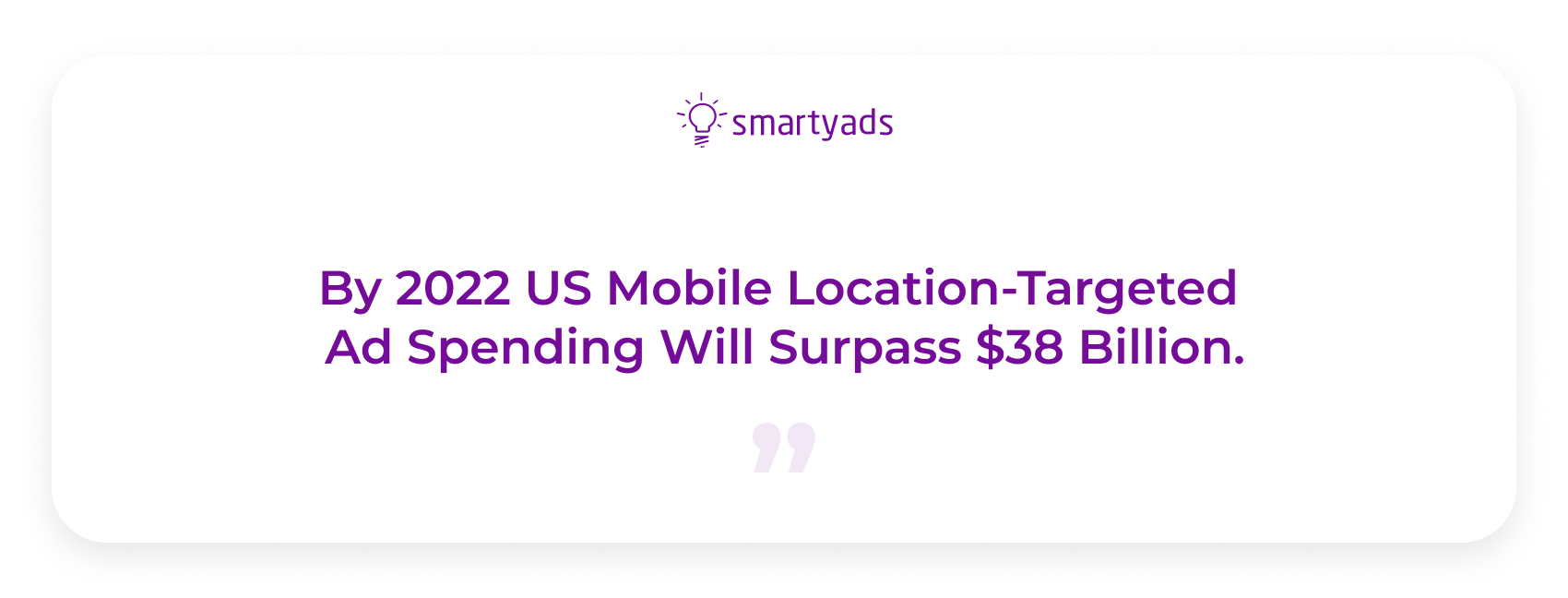
Why is it so effective today?
Now that we see the scale of location-based targeting, it is sensible to come up with the question - how can this be so efficient? Why do advertisers from all over the world spend billions on geo-targeting yearly? To find the answer, let us consider the factors that make this programmatic ads strategy so successful.
Applying the magic of personalization
Once you start to personalize your messages, it is much more likely that many people will find them relevant and thus, effective. In fact, the relevance of the ads is often a defining factor for ad viewability. IAB UK reports that almost half of users turn to ad blockers because they receive irrelevant ads too often. Thus, personalize and use location-based marketing campaigns to increase your chances to get noticed.
Apart from this, countless studies confirm that customized ads get much more engagement compared to their generic counterparts. Location-based personalization is not an exception - on the contrary, it helps you understand your customers better and allows you to build much more thoughtful marketing strategies.
Picking the right place
When you use location data you can predict some of the people’s preferences or interests and such an approach can work wonders! For instance, you can make references to the recent local news and events in your messages which will make them much more memorable.
Or you can get even more specific and target audiences by the district for your location-based marketing campaigns. For instance, if they are going out to the city center or shopping at the market, their needs will naturally vary. This way the same person can pay attention to different ads under different circumstances. Whilst using location data details, specific to each region or district, you get a perfect opportunity to stand out.
and choosing the right time
One could say that the main benefit of LBA is the ability to serve ads in the right place. This is true for any type of location targeting, but most of them also give advertisers an opportunity to make their messages timely. Since location-based targeting mobile devices are sharing the GPS location data in real-time, it allows marketers to tailor the ads at specific moments.
Some types of geo-targeting mobile technologies even allow you to reach users in real-time at a certain street or block or trigger a notification when customers are entering/leaving a fixed area, often defined as ‘geo-fence’. This way many people would receive ads only at the time when they are almost ready to convert, while the advertisers could optimize their budgets.
Picking good timing is equally important to choose a precise location, and the solid combination of the two is a golden rule for any successful location-based marketing or targeted ads campaign.
Building trust and new customer connections
Another significant benefit of location marketing is a deeper connection with your clients. When you use location data it allows you to speak your customers’ language and thus achieve better understanding and build trust with them. By providing relevant content you can answer their questions and even merge with the specific ‘vibe’ of the place you are advertising at.
And your clients, in turn, could deepen this connection by checking-in their devices at your retail stores. Sharing their experience on social media could also help to increase brand awareness for your location-based marketing campaigns.
Competing with bigger brands
Local-based advertising is also a must for small local brands that are focused on a precise region or district. Reaching local audiences on a personal level can give your brand a huge advantage in a competition, especially in comparison with national or global companies. This can strengthen the balance between local and global brands, and encourage both sides to be more attentive to their clients to win their loyalty.
With the adoption of LBA, a campaign that would resonate with customers more will naturally bring better results. And in the end, users would choose offers that address their needs with the most relevant solutions.
Making the most out of multiple ad platforms
A good thing about LBA is that it is quite versatile and allows you to leverage multiple platforms and channels. By combining it with a well-planned omnichannel marketing strategy, you can maximize the impact of your location-based marketing campaign and create holistic experiences for your clients at every stage of the advertising funnel. Be it social media or a demand-side platform, location targeting is always out there.
Getting new insights ready
Once you start to define your Internet advertising budget and the campaign’s performance you might notice that working with location-based marketing campaigns can also give you valuable insights. Measuring offline activity after your digital advertising campaign will help you understand the relation between the two, so you would be able to attribute your digital efforts to precise financial results. And the further application of your findings would make your campaigns even more precise and relevant.

How does location-based marketing work?
Now that we’ve learned why we need to use location-based targeting, let us investigate its internal mechanisms. How does location-based advertising work? The truth is, there are several different techniques based on slightly different principles, so to answer this question we should review the most widely used ones in greater detail. Let’s see how you can benefit from such geo-related mobile marketing campaigns and how physical businesses can attract customers with ads in the real world.
- Geotargeting. This type of targeting has been around since the early 2010s and can be considered the original form of location targeting. It utilizes location data provided by mobile operators in real-time and usually includes targeting by IP address. Although this form of targeting isn’t very exact, it is good for targeting on a larger scale - i.e. by state, town, or city. For example, you can advertise online local cuisine to the tourists who have just entered the town or send them push notifications with the best hotel rooms offers.
- Geofencing. This form of location-based marketing allows you to create a defined region or ‘fence’ based on its latitude and longitude coordinates. You can then choose its radius and determine the distance around your store where the users would get your messages. It is often used at the shopping malls to get foot traffic to the stores. For instance, you could suggest time-limited offers to the customers who stay within a certain area around your store or target people who are walking nearby a restaurant during lunch hours.
- Hyper-Contextual Targeting. This strategy of location-based marketing is built around placing mobile ads within specific locations and a certain timeframe. A good example would be sports-related offers placed around the football stadium during an important match. Similarly, a taxi service could display their ads in public transport during peak hours when the commuters are the most annoyed with traffic jams and uncomfortable crowds. It also works well with beacon location-based marketing which we will examine further on in a minute.
- Weather targeting. Similar to hyper-contextual targeting, this technique is focused on temporary changes in the physical environment around a certain point. The natural environment - weather - has one of the biggest impacts on customer behavior and their buying habits. Many people go out to bars and restaurants when the skies are clear and sunny, while home deliveries see increased demand during rains and thunderstorms. Taking into consideration local climate is also important on a wider scale - it simply doesn’t make sense to advertise raincoats to people living in dry climates, but a location-based marketing campaign offering sunglasses could become a real hit at the same spot.
- Geo Conquesting. A slightly more aggressive form of location-based marketing includes engaging your target audience once they approach your competitors’ stores. Geo conquesting is a great way to enhance foot traffic flow to your store within a certain area where people shop. If you carefully research your competitors’ strong and weak points, you can easily leverage this strategy to drive new customers to your stores. Reaching already interested customers with more attractive offers can significantly increase their engagement levels and conversion rates. It is especially beneficial within industries focused on financial services, cafes & restaurants, insurance, and communication.
- Beacon Marketing. Another way to drive foot traffic to your store within a shopping area. As we have already mentioned, this is a technique that works well in combination with other forms of location-based advertising LBA. Beacon marketing is also known as ‘proximity marketing’ and it operates based on the information provided by beacon - a small Bluetooth receiver of location data from nearby devices. Although its targeting area is the smallest among all the other techniques, beacons work exceptionally well for areas without a cellular connection. Beacons are so small and flexible that they could be placed anywhere and reach the closest customers at any point.
Location-Based Mobile Advertising Examples
Although all these terms and techniques sound well in theory, it is always important to monitor real-world examples of location targeting and draw inspiration from the best ones. Here are some of them:
In 2015 Coca Cola started to study the effectiveness of location-based marketing by placing beacons in cinemas in Norway. Once the users entered the cinema they could redeem a famous drink for free. As a result, 50% of users collected free coca-cola and 60% of these continued to use an app where the campaign was placed. Although the experiment didn’t suggest any financial profit, it amply confirmed how beacon marketing could increase customers' engagement and encourage them to interact with brands.
Starbucks started to leverage location-based ads even earlier. In 2014 they used customers’ mobile device ID and geolocation to tailor personalized ads once they get close to one of their venues. Starbucks app users received appealing offers and discounts with push notifications and the results were quite impressive. The company reports, such a campaign increased the chances for a user to enter a store by 100%.
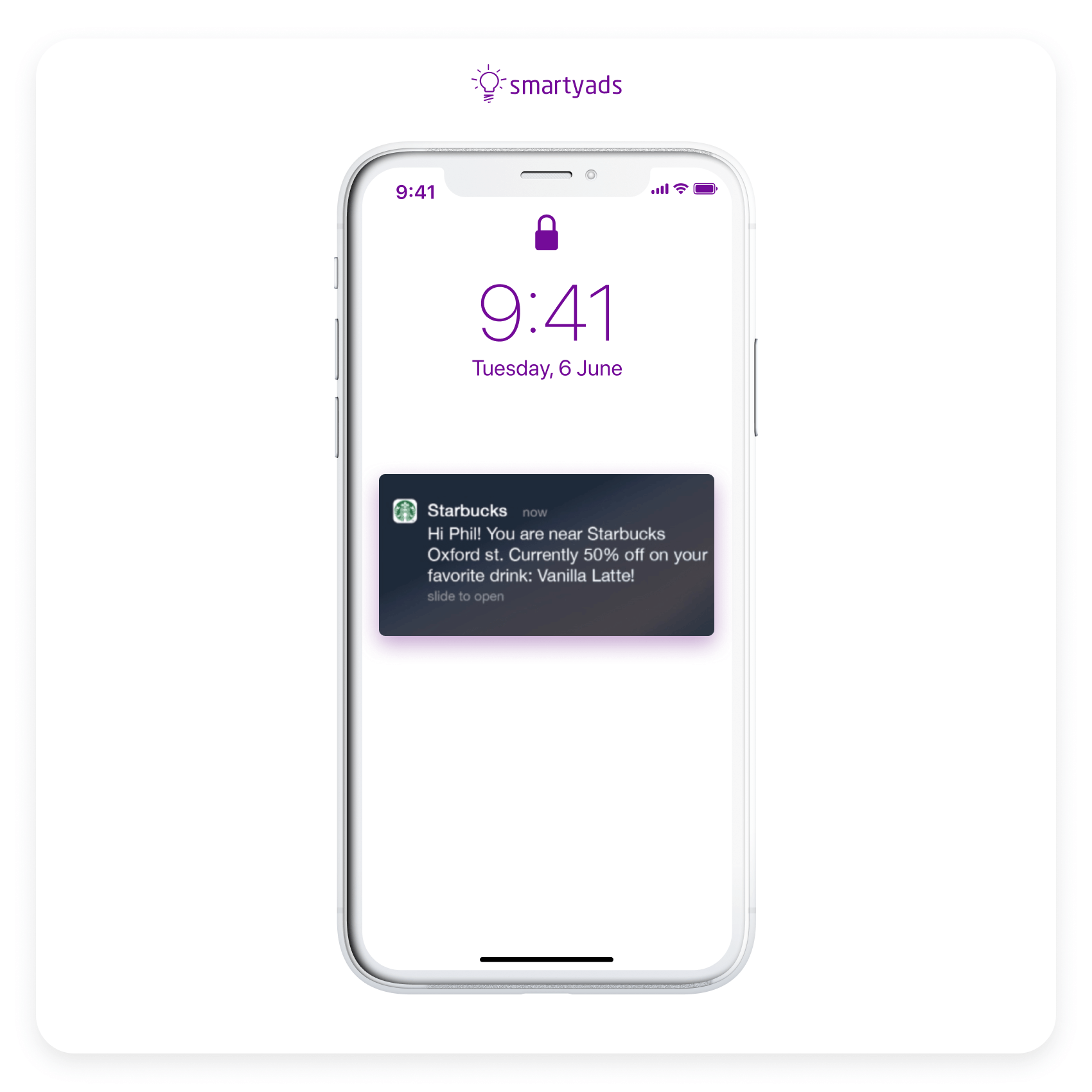
A nice location-based marketing strategy was performed by an alcohol brand - Campari America. They targeted users between the ages of 21 to 34 when they approached areas with a huge number of bars and restaurants, such as city centers, etc. Once the users checked in at a place, they could receive a discount for ride-sharing services provided by another company - Lyft. This allowed the brand to build deeper connections with customers by attending to their needs, while customers, in turn, helped Campari America to build brand awareness by spreading the word among their friends on social media.
Another successful example of a location-based advertising app is the Regent Street app. It allows users to enter their preferences and then suggests relevant recommendations for the stores on the map. Apart from this, consumers can type in the name of the store and get all the necessary information regarding its position in relation to the user. They also provide relevant ads and push notifications from brands that the user showed interest in.
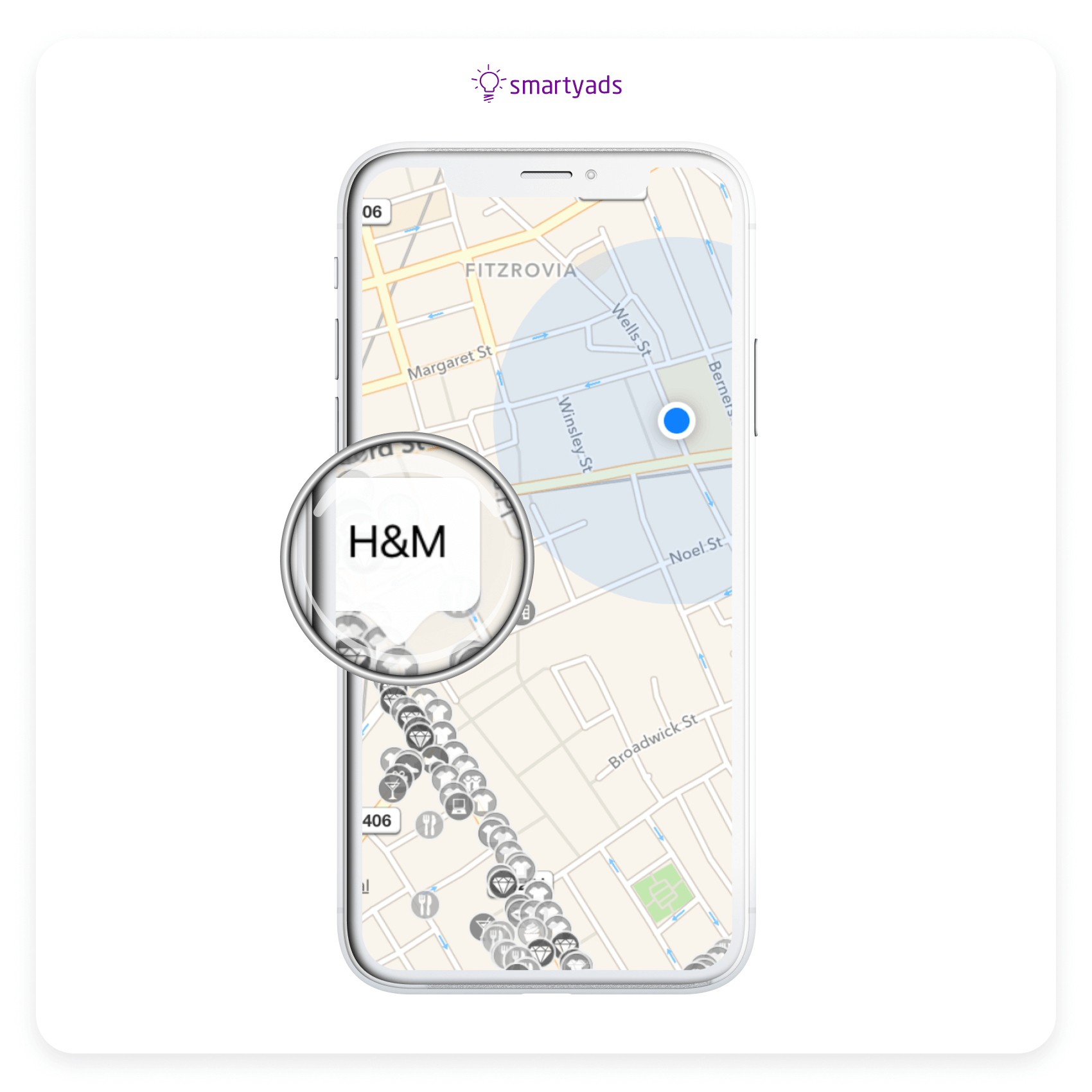
How to launch a location-based marketing campaign?
Although it might seem tempting to jump in the trend and to use location-based marketing campaign immediately, it is crucial to do your homework first - make some research and craft a well-planned strategy before implementing new features to your marketing efforts. Here is a definite step-by-step guide with some tips to help you make the most out of local-based ads:
Step 1. Do your research and make a plan
There are several things to consider before launching a location-based marketing campaign for your brand. First of all, you should consider using location data of your customers and its quality to reflect upon how they move and behave in the real world. Please note that you should only rely on the information that is:
- Accurate - for the case of LBA this means that an estimated user location shouldn’t be too far from their actual position in the first place.
- Precise - the more specific the location data you get, the better you use location-based marketing capabilities so the better campaign will perform. Getting a more detailed geo-position might seem harder, but it will also bring you better results long-term.
- Recent - once the location data was gathered, it goes to the ad servers and data management tools and services. The shorter this path is, the bigger are your chances to get the most recent location data and tailor relevant ads.
Next, create a detailed location-based marketing strategy that goes in accordance with your clients’ needs and your brand’s goals. For more specific information take a look at the following recommendations:
Make sure you know your target audience well by matching geolocation data with demographic and behavioral characteristics to better understand their needs and interests. This will help you deliver appropriate solutions and present them in an appealing manner.
Consider how your customers could benefit from your offers and what they would see as the most important part about it. Then, mark out the best place and time to target the users, as well as the radius of the targeted area. If you can get access to their search and other behavioral data, analyze it to create personalized messages.
Plan your location-based marketing campaign - what type of technologies do you want to use and how will it help reach your business goals? Select one or multiple channels and think on what kind of messages would work best for each. Choose appropriate digital ad formats for each channel and make sure you’ll be able to deliver quality content at every stage of your campaign.
Ideally, you should end up with a seamless omnichannel location-based marketing experience that would match both your brand image and your customers’ needs. Finally, search for the best platforms for media buying - a well-established intuitive DSP with lots of targeting solutions should serve as a perfect place for launching your first campaign.
Step 2. Come up with personalized messages and creatives
The importance of ad creatives is hard to overestimate, as they usually define whether you manage to catch users’ attention and make them your loyal customers. There are many things to work on while creating your perfect message, but some are especially important:
Remember that some formats work better with certain channels, while some perform well for specific business goals. Consider your needs and budget while planning a location-based marketing campaign.
Make sure that the ad won’t disrupt user experience - less vivid but more relevant creative always works better than annoying ads.
Similarly, your ads also shouldn’t be too personal as this may also disturb some of your potential customers. Try to find a balance between personalization and privacy to provide the best experiences.
Moreover, your ads should encourage Internet users to take action and engage with your brand. This can be achieved by many methods, for instance - by placing special offers, discounts, and coupons.
It is also vital to ensure that your mobile ads have a clear call-to-action to make instant decisions and precise directions that would guide many people to your store. You can even include dynamic maps that would lead customers from their specific locations.
Don’t forget about the consistency between your brand image, your offers, and the preferences of your target audience persona. Creative design, color scheme, fonts… all these factors can create a strong sense of integrity of your location-based marketing campaign.
Step 3. Launching your location-based advertising campaign
Once everything’s ready it is time to put it all together and launch your location-based marketing or advertising campaign. After that, you should also manage it properly and optimize its parameters timely in order to get maximum efficiency. Some of the best practices for this step include:
Start with the basic settings such as selecting traffic and device types, as well as active time for your campaign on DSP. Then, move on to targeting. Remember that location targeting works best when complemented with other types of targeting. The task is to show ads only to the right target audience, still, the best practice is to apply several targeting options because when you apply too many you limit your audience extremely so no one will see your ads in the end.
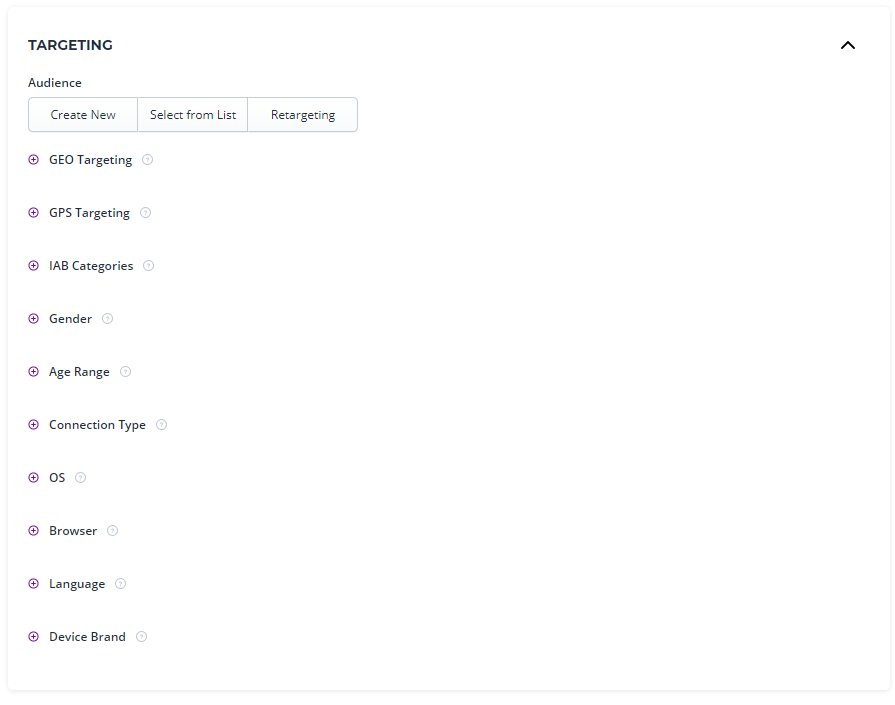
Ensure proper location data collection and analysis via the data-management platforms or any other tool of your choice. This task should help you to determine whether or not your location-based marketing campaign meets your goals and allow you to make all the necessary improvements if it doesn’t. It is essential that every action taken from every ad is tracked and measured. If everything is set up properly, you should be able to monitor your ads’ performance and analyze their strengths and weaknesses to boost your ad campaigns more.
Analyze your budget in relation to the customer lifetime value, which is a metric that shows the average revenue you get from one customer throughout your cooperation. Always keep track of your online ad spend and ensure that your cost-per-acquisition doesn’t surpass customer lifetime value - it should be the other way round - customer lifetime value should be higher than the cost per acquisition.
The bigger the difference, the higher your profits. So, for instance, if your ad spend was $1000 per campaign and it brought you 10 customers with $500-lifetime value each, this means your profit is $4000, and the location-based marketing campaign can be considered successful.
Ask for support if you don’t feel comfortable managing your location-based marketing campaign, or consider hiring an outsourced marketing specialist to get professional help or advice. Don’t hesitate to use DSP guidelines in case you have any questions since you can often find lots of useful information there regarding location-based marketing campaign setup and optimization. You can also find some bits of advice and best practices for targeted advertising on the blog, so don’t forget to check it out from time to time to stay tuned.
To wrap it up
The world of advertising is constantly changing, as the channels and formats are getting more and more diverse. What was at first simple static banner ads has now become a powerful ecosystem with lots of options that work wonders for many businesses.
Within this ecosystem, location-based mobile advertising is a powerful tool for any business goal, be it building awareness and trust with customers or increasing conversions and revenue. Not only does it help to deliver personalized messages to your potential customers, but it also helps your brand to compete and create effective location-based marketing campaigns.
Deliver your messages at the right place on time with SmartyAds DSP!

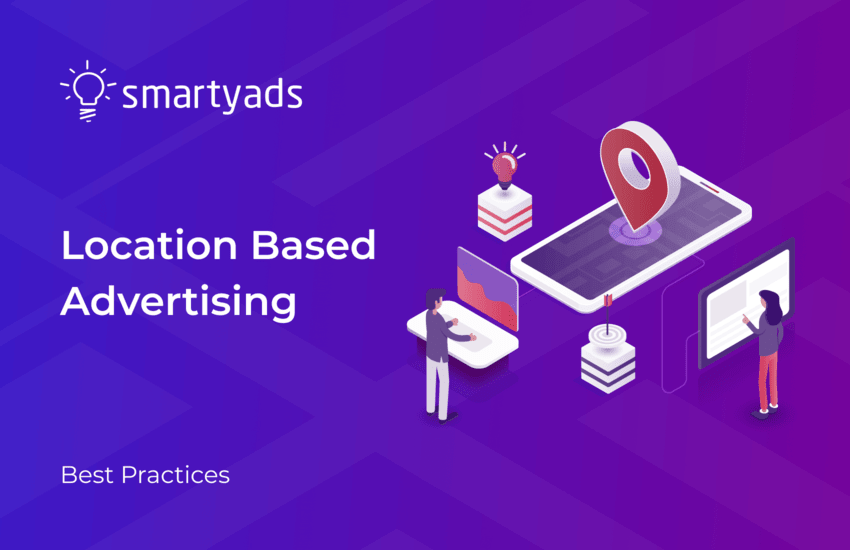
.webp)


